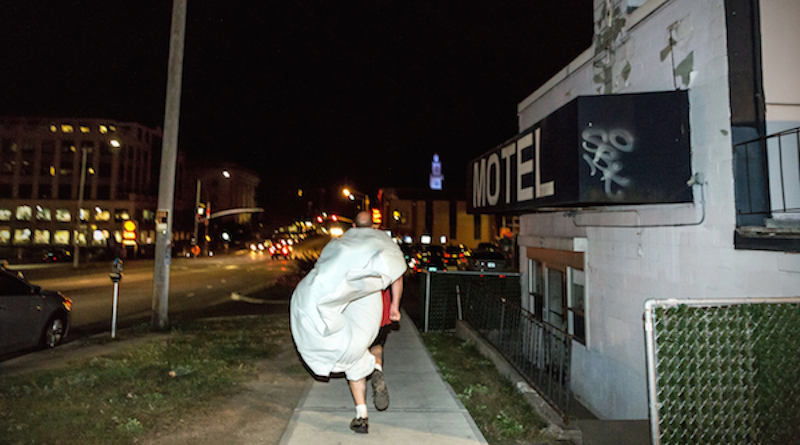Here for the Hash
I can hear the chants from Church Street in downtown Burlington, getting louder as I hurry towards the source:
To-Ga! To-Ga! To-Ga! To-Ga!
In City Hall Park near the bustle Burlington’s pedestrian shopping district, a small crowd of about 20 men and women has gathered, wrapped in sheets or towels in the style you might recognize from the movie “Animal House.” Someone is wearing a kilt and another guy has a t-shirt that reads: I run because I really like beer.
It’s toga night and I didn’t get the memo.
Then the toga-clad mob starts running.
 We swarm through intersections, yelling and blowing on whistles. We scream down College Street, up Pine Street, through bank drive-throughs and down parking garage ramps. We duck through an alley past the Hotel Vermont, crossing Battery Street and dropping to the waterfront, startling the dinner crowd at The Skinny Pancake and snarling traffic. “What the hell is going on?” whines one woman.
We swarm through intersections, yelling and blowing on whistles. We scream down College Street, up Pine Street, through bank drive-throughs and down parking garage ramps. We duck through an alley past the Hotel Vermont, crossing Battery Street and dropping to the waterfront, startling the dinner crowd at The Skinny Pancake and snarling traffic. “What the hell is going on?” whines one woman.
Nobody takes the time to explain where we’re running to, because, in fact, we’re not sure either. All we know is there’s beer waiting for us and we have to find it.
Welcome to the Burlington Hash House Harriers, a group that combines two wonderful things—running and beer—every week for “hashing,” an activity nearly 80 years old that’s now popular around the world among runners and drinkers including Joe Sixpack and your hometown running heroes. You don’t have to be a world-class runner to join; just be of legal drinking age, have a pair of sneakers and a sense of humor and the most fun you can have in Burlington on a Wednesday night could be chasing the trail.
A drinking club with a running problem
Hashing dates back to 1938 in Kuala Lumpur, when British militia members and expatriates began meeting on Monday evenings to run a variation of the traditional British paper chase, a game also called “Hare and Hounds” during which a runner, called the “hare,” leaves a trail of paper for the trailing group of runners, the “hounds,” to chase down.
Along the way, the hare intentionally lays a meandering trail with concealed marks and false trails with dead ends through a variety of rugged terrain. The group met every week at the Selangor Club, which they titled the “hash house” for its uninventive fare and named their group the Hash House Harriers. Their trails ran in wandering routes through sugar plantations and through the bustling street markets, always ending with a cache of beer. After the Second World War, kennels (the name still used for hashing group) began popping up in Europe, Malaysia, Singapore, Brunei and Australia.
In 1950, when the government of Kuala Lumpur decreed that all clubs be registered and have a set of rules, the “Mother Hash,” as the group came to be known, penned the first charter with just four objectives:
- Promote physical fitness among our members
- Get rid of weekend hangovers
- Acquire a good thirst and to satisfy it in beer
- Persuade the older runners that they are not as old as they feel
It’s a basic list that continues to guide all of today’s hashes. Nearly 80 years later, it is possible to travel around the world and participate in a hash in nearly every major city on the way. There have even been hashes in Antarctica. As the activity has increased in popularity, groups maintain a degree of secrecy; the online hashing resource HashSpace requires an invite from another hasher to join, keeping out lurkers. (Most hashers have fulltime jobs and employers who might not appreciate the antics that occur when employees run around after dark drinking beer in public).
But that’s not to say hashers are an unwelcoming crowd. Meeting locations and times for hashes are always posted on kennels’ websites and attract a group that under different circumstances might never run or drink beer together. As a hasher named Suzy Homewrecker told me, “If you like beer and debauchery and can trot along, then you’re one of us.”
It was an invitation I couldn’t resist: I joined a kennel.
Beer near
My experiment with hashing began on a Wednesday night August in Hinesburg at the house of one hasher named Brokeback Lumberjack.
Clouds were moving in and threatening rain as I watched a line of vehicles crawl up the gravel road and park on the lawn next to me. As my companions finished lacing up their running shoes, I waved hello and finished the can of Coors Light Brokeback had offered.
After a group of about ten gathered, sporting “cranium lamps” (hashing pro-tip: nobody says “head”) and knee-length socks labeled with the hashing cry of “on-on” (this saying borrowed from a British Air Force squadron is yelled when the hash has located the trail), our two hares joined us. Wearing only dirty orange chainsaw chaps over their underwear, they packed bags of flour into a backpack and disappeared into the woods. Hares often scout their trails ahead of time, using Google Maps or MapMyRun to analyze terrain, plot routes and arrange locations for beer checks.
We gave them ten minutes to create some space while we gathered for the opening circle, one of hashing’s traditions where hashers introduce themselves, identify any first-timers (referred to as “virgins”), review the marks the hares will use on the trail and sing a song. Many of the popular songs in kennels are taken from rugby songs and feature hilarious, X-rated revisions.
Here’s an abridge version of a popular one, sung to the tune of “Campton Races:”
There’s a bear in the deep dark woods
Yogi, Yogi
There’s a bear in the deep dark woods
Yogi, Yogi Bear
Yogi has a girlfriend
Cindy, Cindy
Yogi has a girlfriend
Cindy, Cindy Bear
Cindy is a frigid bitch
Polar, Polar…
You can see where this is going.
As it started to rain, we ran for the cover of the trees, looking for the first spot of flour indicating the start of the trail.
There are marks that let hashers know they’re on the right trail; tell them to backtrack; order them to sing songs or—hopefully—indicate that there’s beer nearby.
Many hashes run through cities and towns in Chittenden County. Hares lay trails on streets, sidewalks, alleyways, playgrounds, parking garages, waterfronts and shopping malls in Burlington, Winooski, Williston, Colchester and other urban areas, but the trail through Hinesburg had us on narrow singletrack trails, dirt roads, rugged four-wheeler trails and occasionally bushwhacking around the town forest. Darkness fell quickly.
While hunting for piles of flour the size of anthills with my “cranium lamp” I struck up a conversation with Jersey Lunchbox, an electrical engineer at Global Foundries in Essex Junction. I asked where the name came from.
Every hasher receives a name after their fifth or so consecutive hash, derived from wild escapades, physical traits or sometimes just dreamed up by the rest of the kennel. Names are often full of sexual innuendo and the overall sense of humor is unabashedly that of a 14-year-old boy. Some hashers don’t even know the real names—also called “nerd names”—of their fellow hashers and when they run into each other outside of the hash, rather than greet each other as “Glo Balls or “Got Milk” they often just nod and say, “On-on!”
That said, it’s all in good fun and since it was only my third hash, I didn’t have a name. Newer hashers are referred to by “just” followed by their first names. As of this writing, I’m still “Just Evan.”
Lunchbox told me this is his first year hashing and got his nickname from his girlfriend, who joined him on his first hashes. That girlfriend is now an ex, but he’s still hashing.
“It’s interesting how many people from science or engineering fields are into hashing,” he said while we crashed through underbrush. “It’s been a good way to meet people.”
Lunchbox and I followed the winding singletrack up a steep hill, picking out splatters of flour and hollering down the hill to the hashers behind us until we found a pair of arrows that pointed in two directions: one labeled “E” and the other with a “T.” The “E” arrow pointed directly uphill, over a series of boulders and through some thick undergrowth
Lunchbox clarified: You can take the harder and shorter route, and be an Eagle or you can opt for the longer and more gentle route, and claim the title of Turkey. Thinking we were close to the beer, we took the left and charged uphill.
On the next leg of the hash I found myself alongside Stubby Pink Torpedo and Suzy Homewrecker. Torpedo was tall and thin with a goatee and carried a stuffed rabbit on a stick he found on a previous hash. He’s been hashing for the past 15 years. After spending days at work, he described hashing as a release.
“You come out and act like a kid—but with beer,” he says. “It’s like Halloween. Most people think it’s a run followed by a beer, but when they show up at opening circle, it’s culture shock. You can always pick out virgins by the look on their faces.”
Suzy Homewrecker, a hasher from the Burlington area who works in childcare agreed:
“Out here I’m Suzy Homewrecker,” she said with a note of pride. “I’m not responsible for anyone and I’m here for a good time.”
Just in front of us, our cranium lamps illuminated the letters BN (Beer Near) pointing us further up the four-wheeler track, where the hares waited next to a cooler backpack filled with Labatt Blue.
After four miles, beer goes down surprisingly easy.
The On After
We wrapped up the trail at a clearing not far from where we started. Surrounded by tiki torches, our hares Just Vargus and Brokeback Lumberjack stoked a bonfire that roared high into the trees. A picnic table nearby was piled high with coolers of water, marinating chicken breasts and bratwurst, more Labatt Blue, toilet paper and homemade pickles.
What followed was another hash ritual called the “On In” that highlights the high and low-points of the trail with a few rounds of beers. Beer is both a celebratory act and a punitive measure; in hashing it’s the entire point of the evening.
Did the hares lay a terrible trail with not enough flour that had everyone wandering around in the rain and the dark? Make ’em drink.
Is this your first hash? Drink, virgin.
Did you miss three or more hashes? You guessed it. Cheers.
Hashers also issue beers for wearing overly athletic apparel, not following directions, finishing first or “dead f’ing last.” When all the accusations have been made, the circle wrapped up with a bawdy revision of “Swing Low Sweet Chariot” and the attention turned to the fire and food at hand. Someone plugged a radio into a big 6-volt battery, tuned the dial to a top-40 station and the “On After” began. Most times the post-hash party is at a local bar, a neighboring hasher’s backyard or in the parking lot, but the woods of Hinesburg afforded the opportunity for massive bonfires, grilled food and raucous games of cornhole.
While Brokeback Lumberjack grilled the chicken, another hasher from Burlington named Roscoe told me about his own hashing history. At 54, he’s been a longtime runner with plenty of marathons under his belt. He’s also run the 100 on 100 —the 100-mile relay from the Trapp Family Lodge in Stowe to Okemo Mountain Resort in Ludlow. Roscoe started hashing while he was living in the Montpelier area and noticed the hashes that used to be listed in the activities calendar of Seven Days and came to his first hash with the Burlington kennel on July 31, 2008.
In his early hashing experience, Roscoe discovered that the hashing community often shadows the mainstream running world. Over the weekend prior to the Boston Marathon, Roscoe ran a long Friday evening hash, a Saturday hash and a “hangover hash” on Sunday. He followed this weekend of running and beer with the legendary Boston Marathon on Monday morning – finishing in three hours, forty minutes.
He’s also traveled to hashes in Portland, Me., Boston, and Albany, N.Y., camping out, hashing for the weekend and then heading home.
“I’ve had some of the best times on hashes and I’ve had some of the worst,” he said while snacking on pickles. “It’s a community that welcomes everyone regardless of experience or their enthusiasm.”
Some people come for the running and the affable atmosphere, others come for more beer and get home with a designated driver; all are welcome. In August, a crowd of over 50 celebrated the 500th trail in Burlington’s Oakledge Park with more sunset swimming, grilled food and beer than running.
Just Vargus, one of our hares for this evening, described hashing while abroad. At 36, he spends most of his time living in Sweden, where he works as a novelist. When Brokeback Lumberjack went over to visit this past year, they managed to catch up with the Stockholm chapter of the Hash House Harriers on a hash through the Swedish capital. Their Scandinavian co-hashers were friendly, following many of the same hashing traditions they knew from across the pond—even performing many of the songs and directions in English.
“It was everything we enjoyed but in a foreign city,” he said. “The experience was very much the same.”
There are international hashes spanning the globe from Hong Kong to Cardiff, Wales to Bali, where over 4,000 people have scheduled a hash in 2016. These massive hashes feature multiple trails of varying distances.
Vargus was saying something else about hashing around Stockholm when an explosion as loud as a rifleshot left our ears ringing. Everyone swore and leapt backwards, resuming conversations away from the fire or behind the cover of trees. The explosion was revealed to be a can of creamed corn, tossed in the coals for a very loud prank by none other than the second of our hares, Brokeback Lumberjack. The smell of singed veggies lingered.
“It’s the most fun you can have with 69 cents,” he laughed from the safety of behind the grill. “And watch out, there’s still another one.”
The toga and the trail
 After running through the woods of Hinesburg, the following week we completed a Beer Mile on the Burlington Bike Path, a daunting feat that requires a runner to drink a full 12-ounce can of beer before every quarter mile (The world record set this year is held by Canadian Lewis Kent who drank four Amsterdam Blondes and finished in 4:55.8, faster than most people run a mile without a stomach-swelling with lager).
After running through the woods of Hinesburg, the following week we completed a Beer Mile on the Burlington Bike Path, a daunting feat that requires a runner to drink a full 12-ounce can of beer before every quarter mile (The world record set this year is held by Canadian Lewis Kent who drank four Amsterdam Blondes and finished in 4:55.8, faster than most people run a mile without a stomach-swelling with lager).
Tonight on our Toga Hash through Burlington our hare for the evening has laid a “Cajun” trail, meaning that the typical checks for the trail can go in any direction, regardless of which way the arrow points. The city’s parks, neighborhoods, shopping malls and back alleys are all fair game and the trail is disorienting. Every mark has us spread out in a wide radius, looking for the direction to go. Eventually a whistle sounds or someone gives a holler and the rest of the pack takes off in the new direction.
In a Venn diagram, hashing exists in the overlapped area between “runners’ and “drinkers” and a typical trail caters to the strengths of both groups. In the running camp, stronger runners can stretch out ahead, but backtrack if they lose the trail to rejoin the rest of the group. Meanwhile, slower runners alternate running with short breaks. In this way, the hash inadvertently accommodates runners of all strengths through the use of “Fartlek,” the Swedish word for “speed play” that blends continuous distance running with interval training.
And for those a that enjoy the beer more than the run, their reward comes at the end.
At our first beer check, we can see the mountains across Lake Champlain standing in silhouette against a deepening purple and orange sunset. Beers are distributed from a cooler in the back of a car and everyone leans or sits on the wall, enjoying another beautiful Vermont evening. It is the first day of fall. Hashes continue into October and are held on special occasions including Halloween, Thanksgiving, New Years Day and Mardi Gras but only resume their weekly schedule in April.
HB (the abbreviation for his hash name) is a retired a middle school band teacher from northern Vermont. At 63, he’s been hashing for the past 12 years and that’s all he’s willing to disclose.
“However bad, I do have a reputation to uphold,” he tells me.
Hashing is now in his family and HB was in San Diego for his daughter’s naming with a kennel she hashes with regularly. Her name is derived from her occupation as a professional pilot.
“It was a proud moment,” he says dryly.
While we overlook the water sipping Pabst, HB goes on to tell me about a deeper connection he has with the Burlington group. When he lost his brother to cancer two years ago, the first people to send flowers and condolences were his fellow hashers. For him, it’s a community that takes care of its members.
“You don’t forget that,” he says. “You never know where your friends will come from.”
 Just then, a Burlington police car trolls into the lot and backs into a parking space nearby. The crowd of people wearing togas tromping down to the lake must have piqued the officer’s curiosity and so he spends the next 15 minutes observing. The Burlington hashers are wary of police presence; sometimes officers inquire why they’re all running, but mostly, the two groups don’t clash. Nonetheless, while the cruiser sits nearby with the engine running, any open beer cans are slipped under togas or discretely positioned behind backs.
Just then, a Burlington police car trolls into the lot and backs into a parking space nearby. The crowd of people wearing togas tromping down to the lake must have piqued the officer’s curiosity and so he spends the next 15 minutes observing. The Burlington hashers are wary of police presence; sometimes officers inquire why they’re all running, but mostly, the two groups don’t clash. Nonetheless, while the cruiser sits nearby with the engine running, any open beer cans are slipped under togas or discretely positioned behind backs.
HB acknowledges that hashing takes some getting used to; when it comes to starting hashing, he says most people officially start twice:
“The first time you’re going to say, ‘these people are insane and I’m not sure I want to do it.’ But the second time you’ll say, ‘Yeah, these people are insane, but they’re really nice people,’” he explains.
There next to the lake, I find myself agreeing with him. Despite the sore feet and having a full can of Bud Light dumped on my head at one point (my punishment for arriving sans toga), being lost on a deceptive trail in the dark and the long drive home, I’ve been looking forward to this all week. Later, following closing circle we head off in the direction of a change of clothes and slices of pizza in downtown, satisfied, yet already looking forward to the next trail.



